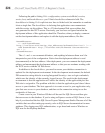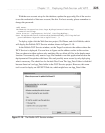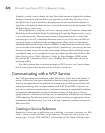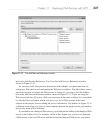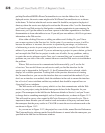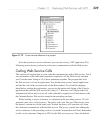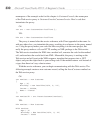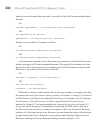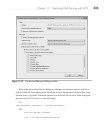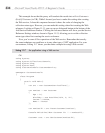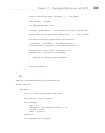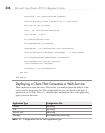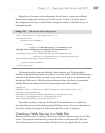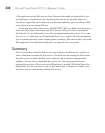
332 Microsoft Visual Studio 2010: A Beginner’s Guide
wanted to see the changes that were made, you could call the GetCustomer method again,
like this:
C#:
Customer updatedCust = svc.GetCustomer(cust.CustomerID);
VB:
Dim updatedCust As Customer
updatedCust = svc.GetCustomer(cust.CustomerID)
Similarly, you can delete a Customer, as follows:
C#:
svc.DeleteCustomer(updatedCust.CustomerID);
VB:
svc.DeleteCustomer(updatedCust.CustomerID)
As in the previous example, we use the service proxy reference to call the DeleteCustomer
method, passing in an ID from the updated customer. The updatedCust reference was from
the previous call to GetCustomer. If you wanted to get all of the Customer records from the
Web service, you could call GetCustomers, like this:
C#:
Customer[] customers = svc.GetCustomers();
VB:
Dim customers As Customer()
customers = svc.GetCustomers()
While this is similar to other method calls in previous examples, you might notice that
the return value from GetCustomers here is an array of Customer, Customer[] (Customer()
in VB). However, the Web service defined GetCustomers as returning a List of Customer,
List<Customer> (List(Of Customer) in VB), as specified in the ICustomerService
interface in Listing 11-2 and implemented in the CustomerService class in Listing 11-5.
As you may recall, the proxy is responsible for translating the XML return value from
the Web service into an object, or collection of objects in this case. By default, the proxy
translates all collections into an array. However, you can change the return collection type
by right-clicking the Service Reference in your project and selecting Configure Service
Reference, showing the Service Reference Settings window in Figure 11-13.



